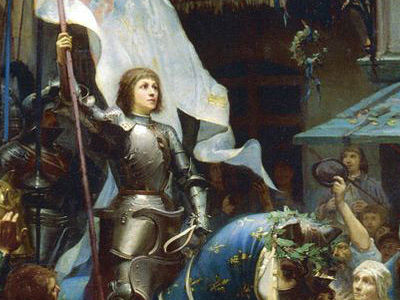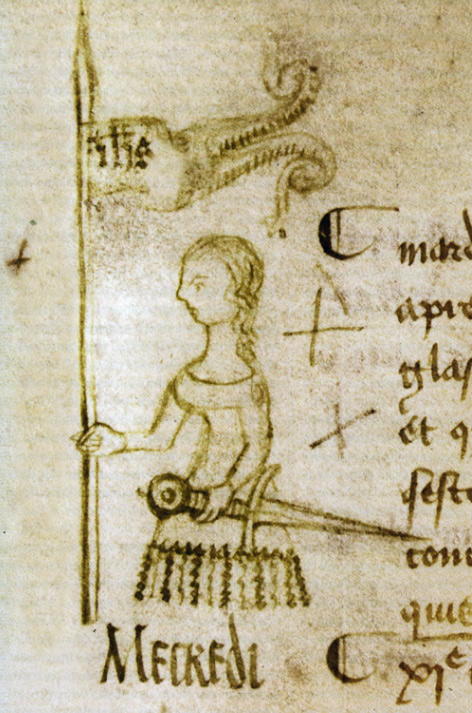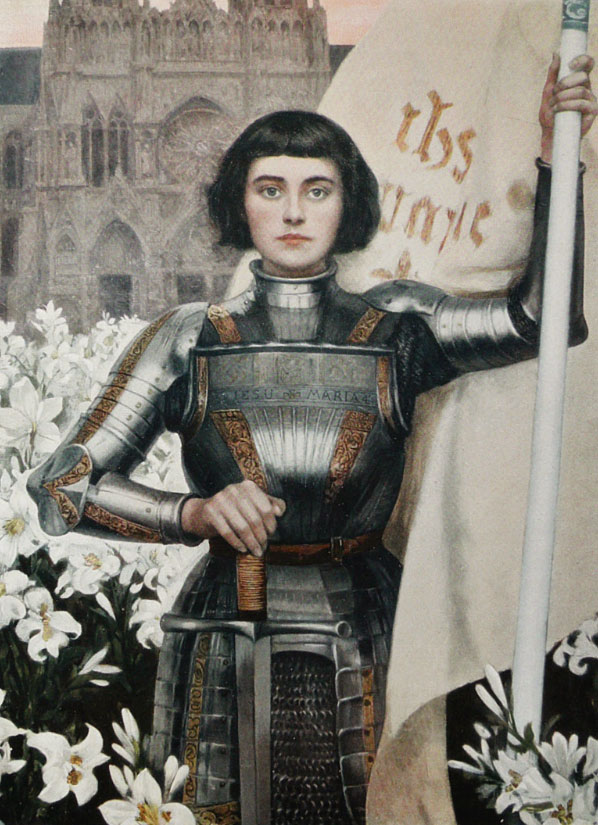Joan of Arc (1412-1431)
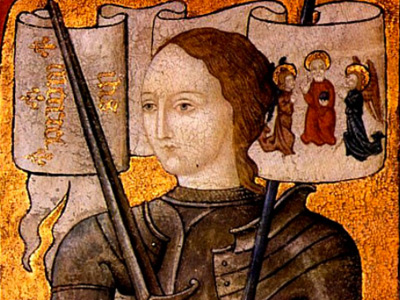
Legacy
Joan of Arc became a semi-legendary figure for the four centuries after her death. The main sources of information about her were chronicles. Five original manuscripts of her condemnation trial surfaced in old archives during the 19th century. Soon, historians also located the complete records of her rehabilitation trial, which contained sworn testimony from 115 witnesses, and the original French notes for the Latin condemnation trial transcript. Various contemporary letters also emerged, three of which carry the signature Jehanne in the unsteady hand of a person learning to write. This unusual wealth of primary source material is one reason DeVries declares, "No person of the Middle Ages, male or female, has been the subject of more study."
Joan of Arc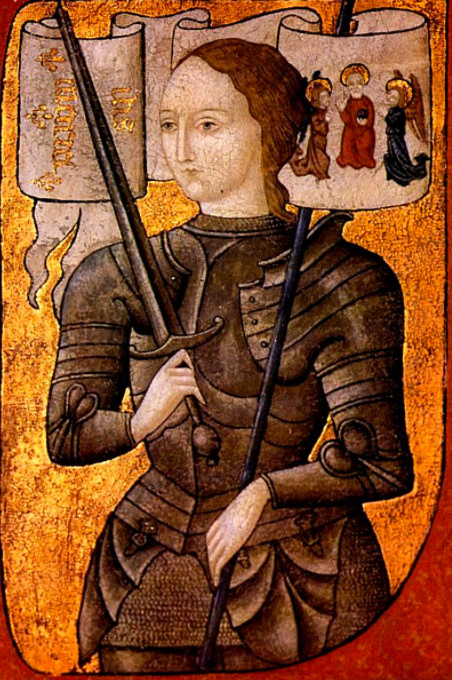 Joan of Arc (1412-1431), is considered a heroine of France for her role during the Lancastrian phase of the Hundred Years' War and was canonized as a Roman Catholic saint. She gained prominence after the siege was lifted only nine days later. This long-awaited event boosted French morale and paved the way for the final French victory. Joan of Arc » came from an obscure village and rose to prominence when she was a teenager, and she did so as an uneducated peasant. The French
Joan of Arc (1412-1431), is considered a heroine of France for her role during the Lancastrian phase of the Hundred Years' War and was canonized as a Roman Catholic saint. She gained prominence after the siege was lifted only nine days later. This long-awaited event boosted French morale and paved the way for the final French victory. Joan of Arc » came from an obscure village and rose to prominence when she was a teenager, and she did so as an uneducated peasant. The French The Kingdom of France is the historiographical name or umbrella term given to various political entities of France in the medieval and early modern period. It was one of the most powerful states in Europe since the High Middle Ages. It was also an early colonial power, with possessions around the world. Colonial conflicts with Great Britain led to the loss of much of its North American holdings by 1763. The Kingdom of France adopted a written constitution in 1791, but the Kingdom was abolished a year later and replaced with the First French Republic. and English kings had justified the ongoing war through competing interpretations of inheritance law, first concerning Edward III's claim to the French throne and then Henry VI's. The conflict had been a legalistic feud between two related royal families, but Joan transformed it along religious lines and gave meaning to appeals such as that of squire Jean de Metz when he asked, "Must the king be driven from the kingdom; and are we to be English?" In the words of Stephen Richey, "She turned what had been a dry dynastic squabble that left the common people unmoved except for their own suffering into a passionately popular war of national liberation." Richey also expresses the breadth of her subsequent appeal:
The Kingdom of France is the historiographical name or umbrella term given to various political entities of France in the medieval and early modern period. It was one of the most powerful states in Europe since the High Middle Ages. It was also an early colonial power, with possessions around the world. Colonial conflicts with Great Britain led to the loss of much of its North American holdings by 1763. The Kingdom of France adopted a written constitution in 1791, but the Kingdom was abolished a year later and replaced with the First French Republic. and English kings had justified the ongoing war through competing interpretations of inheritance law, first concerning Edward III's claim to the French throne and then Henry VI's. The conflict had been a legalistic feud between two related royal families, but Joan transformed it along religious lines and gave meaning to appeals such as that of squire Jean de Metz when he asked, "Must the king be driven from the kingdom; and are we to be English?" In the words of Stephen Richey, "She turned what had been a dry dynastic squabble that left the common people unmoved except for their own suffering into a passionately popular war of national liberation." Richey also expresses the breadth of her subsequent appeal:
"The people who came after her in the five centuries since her death tried to make everything of her: demonic fanatic, spiritual mystic, naive and tragically ill-used tool of the powerful, creator and icon of modern popular nationalism, adored heroine, saint. She insisted, even when threatened with torture and faced with death by fire, that she was guided by voices from God. Voices or no voices, her achievements leave anyone who knows her story shaking his head in amazed wonder"
From Christine de Pizan to the present, women have looked to Joan as a positive example of a brave and active woman. She operated within a religious tradition that believed an exceptional person from any level of society might receive a divine calling. Some of her most significant aid came from women. King Charles VII's mother-in-law, Yolande of Aragon, confirmed Joan's virginity and financed her departure to Orléans. Joan of Luxembourg, aunt to the count of Luxembourg who held custody of her after Compiègne, alleviated her conditions of captivity and may have delayed her sale to the English. Finally, Anne of Burgundy, the duchess of Bedford and wife to the regent of England The Kingdom of England was a sovereign state on the island of Great Britain from about 927, when it emerged from various Anglo-Saxon kingdoms, until 1 May 1707, when it united with Scotland to form the Kingdom of Great Britain. The Viking invasions of the 9th century upset the balance of power between the English kingdoms, and native Anglo-Saxon life in general. The English lands were unified in the 10th century in a reconquest completed by King Æthelstan in 927., declared Joan a virgin during pretrial inquiries.
The Kingdom of England was a sovereign state on the island of Great Britain from about 927, when it emerged from various Anglo-Saxon kingdoms, until 1 May 1707, when it united with Scotland to form the Kingdom of Great Britain. The Viking invasions of the 9th century upset the balance of power between the English kingdoms, and native Anglo-Saxon life in general. The English lands were unified in the 10th century in a reconquest completed by King Æthelstan in 927., declared Joan a virgin during pretrial inquiries.
Three separate vessels of the French Navy have been named after her, including a helicopter carrier that was retired from active service on 7 June 2010. At present, the French far-right political party Front National holds rallies at her statues, reproduces her image in the party's publications, and uses a tricolor flame partly symbolic of her martyrdom as its emblem. This party's opponents sometimes satirize its appropriation of her image. The French civic holiday in her honour, set in 1920, is the second Sunday of May.
During World War I World War I, also known as the First World War, or the Great War, was a global war originating in Europe that lasted from 28 July 1914 to 11 November 1918. More than 70 million military personnel, including 60 million Europeans, were mobilized in one of the largest wars in history. The war drew in all the world's economic great powers, assembled in two opposing alliances: the Allies versus the Central Powers of Germany and Austria-Hungary. View World War I », she was frequently used as an icon in musical works. Some notable songs include "Joan of Arc", "Joan of Arc, They Are Calling You", and "Joan of Arc's Answer Song".
World War I, also known as the First World War, or the Great War, was a global war originating in Europe that lasted from 28 July 1914 to 11 November 1918. More than 70 million military personnel, including 60 million Europeans, were mobilized in one of the largest wars in history. The war drew in all the world's economic great powers, assembled in two opposing alliances: the Allies versus the Central Powers of Germany and Austria-Hungary. View World War I », she was frequently used as an icon in musical works. Some notable songs include "Joan of Arc", "Joan of Arc, They Are Calling You", and "Joan of Arc's Answer Song".
HISTORY
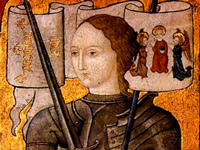
RESOURCES
This article uses material from the Wikipedia article "Joan of Arc (1412-1431)", which is released under the Creative Commons Attribution-Share-Alike License 3.0.
© Stories Preschool. All Rights Reserved.
